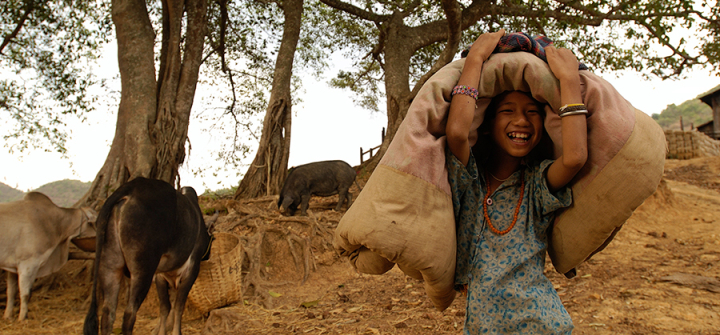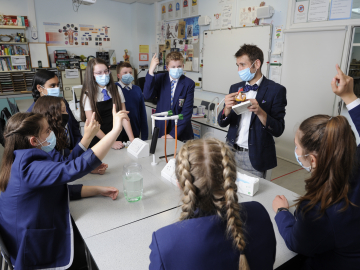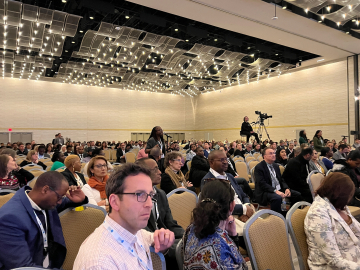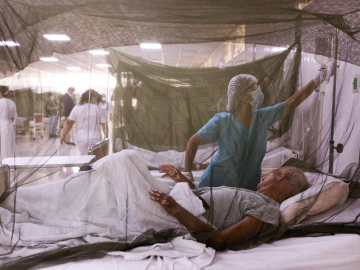Best Global Health Stories of 2017
Best Global Health Stories of 2017: Editors' Choices
It's time for GHN's annual year-end tradition: Our writers and editors have brought back their favorite stories about global health. Below, we revisit just a sampling of the year's best journalism about global health.
Tipping Point?
A widely available vaccine and a 99.9% effective treatment protocol is finally yielding hope against cholera, reports Donald G. McNeil, Jr. from Bangladesh for The New York Times.
The International Center for Diarrheal Disease Research, Bangladesh (ICDDR,B), in Dhaka has perfected treatment against the cholera bacterium and other pathogens like rotavirus that cause diarrheal disease. The ICDDR,B team at the world’s largest diarrhea hospital rapidly replaces the electrolytes, glucose and water that cholera expels, saving the lives of the 200,000-plus patients per year.
A stockpile of cholera vaccine too has shifted the balance against cholera internationally.
Replete with history, powerful observation and controversy, this is a must-read global health article.
Donald G. McNeill, The New York Times
February 6, 2017
“Liquid Genocide”
The Wounds of Whiteclay investigative journalism project delivered a hard-hitting look at the staggering toll of alcoholism on the Pine Ridge Reservation in South Dakota just across the Nebraska border.
Even more impressive: Journalism students from the University of Nebraska produced the project, which details generations of “liquid genocide” on the reservation.
The Wounds of Whiteclay chronicles the toxic relationship between Pine Ridge, where alcohol is illegal, and the tiny town of Whiteclay, Nebraska, where liquor sales, over the past century, have fueled an epidemic of alcoholism on the 40,000-member reservation.
But the Nebraska Liquor Control Commission’s 2017 decision to revoke Whiteclay’s 4 liquor licenses is a long-awaited first step toward addressing the damage from decades of unfettered alcohol sales.
“It’s a small victory, but it’s nowhere near what our nation needs,” said Olowan Martinez, a Pine Ridge activist. “This is just a small step in ending the liquid genocide, so we’re happy, and surprised, but it ain’t over yet.”
Rebekka Herrera-Schlichting and Roger Holmes, University Of Nebraska-Lincoln, College of Journalism and Mass Communications
May 2017
56 Years a Slave
The last article Pulitzer Prize-winning journalist Alex Tizon published before his death tracked his gradual realization that the woman who helped raised him was a slave.
The remarkable account quickly became required reading across the Twittersphere—as did the readers’ comments, expressing everything from admiration for his honesty to claims he “aided and abetted in slavery.”
Gifted to the family at 18 years old, Eudocia Tomas Pulido endured persistent abuse at the hands of Tizon’s family for decades, while forming close bonds with their adoring children. When she finally returned to the Philippines at the end of her life, “childhood friends… were like strangers.”
June 2017
The Quest for Zero
All suicides are preventable: That is the bedrock belief of Zero Suicide, a strategy that aims to eradicate suicide by providing supports to all those at risk. The zero approach focuses on reducing stigma, making care accessible and restricting access to means of suicide.
First practiced in a Detroit hospital more than a decade ago, Zero Suicide has now been adopted by large clinical networks in the UK, including Mersey Care, which serves 10 million people.
With an average of 17 suicides a day in 2015, the UK has a long road to zero. But even if eradication isn’t possible, argues Steve Mallen, a Zero Suicide advocate who lost his son to suicide, “we must strive towards that.”
Simon Usborne, The Guardian
August 1, 2017
Inoculation Imperative
What would it take to vaccinate the world? This stunning National Geographic narrative follows one of the most expensive vaccines in history.
This year, as developed nations faced measles outbreaks due to refusal—not lack—of vaccines, National Geographic asked: What would it take to vaccinate the world?
Vaccine development is astonishingly expensive and can take decades. This stunning photo essay follows one of the most expensive vaccines in history—the pneumococcal conjugate vaccine (PCV)—and its 2015 introduction in Bangladesh, where the common bacteria causes permanent brain damage in children and devastates impoverished families who must provide lifelong care.
By Cynthia Gorney, photographs by William Daniels– National Geographic
Thursday, October 26, 2017
Death in Mongolia
Mongolia, a country “punching above its weight in palliative care,” outranks several countries with more money and better health care systems.
Andrew North’s vividly written account captures the essence of life in Mongolia—and highlights a global health success story from a country not covered frequently by the mainstream media. He brings us the story of physician Odontuya Davaasuren, who began pushing for government reforms in 2000 after her father’s death from lung cancer. Today, every provincial hospital has 5 or more palliative care beds and a morphine dispensary, and the national health service must offer palliative care to dying patients.
Andrew North, Mosaic Science
April 4, 2017
Poisoned Paralysis
Like so many stories that fade as news cycles move on to fresher, more urgent headlines, the Flint, Michigan water crisis continues to unfold outside of the media spotlight. Worse, nearly 7 months after the EPA gave $100 million to Flint, Michigan to replace its lead pipes, not much has changed.
This Bloomberg photo essay puts faces and names to the ongoing quagmire that is Flint’s water crisis. Some 8,000 children have been identified as having high levels of lead in their blood. The city is struggling to replace crumbling pipes amidst bureaucratic mayhem. Residents are strapped with $11,000 water bills and relying on bottled water from the city’s 4 remaining distribution sites.
The photos deliver a blunt reminder: This is a crisis that is far from over.
Bloomberg
October 9, 2017
Smoking Bombshell
A sprawling tobacco industry investigation revealed a secret campaign by Philip Morris International to undermine worldwide anti-smoking like taxes and health warnings.
Company reps met secretly with government officials and delegates from around the world to try to dilute anti-smoking measures, Reuters discovered.
The massive lobbying effort specifically targeted the WHO’s Framework Convention on Tobacco Control treaty, ratified by 90% of countries and credited with helping prevent 22 million smoking-related deaths. Reams of leaked internal documents, some published by Reuters, showed that the company views the treaty as a "regulatory runaway train" driven by "anti-tobacco extremists.”
Aditya Kalra, Paritosh Bansal, Duff Wilson, and Tom Lasseter, Reuters
July 23, 2017
More 2017 Must-Reads:
What Bullets Do to Bodies – Jason Fagone, Huffington Post
April 27, 2017
Chasing A Killer – Lena H. Sun with photos by Melina Mara, The Washington Post
November 3, 2017
“People’s science”: How West African communities fought the Ebola epidemic and won, IRIN
January 26, 2017
The Family That Built an Empire of Pain – Patrick Radden Keefe, The New Yorker
October 30, 2017
[Letter from Ghana]: A Prayer’s Chance: The scandal of mental health in West Africa, Harper’s Magazine
May 2017
Dr. Sanjay Gupta's dire warning on Puerto Rico, CNN
October 3, 2017
A girl in Burma. Image by Shehzad Noorani




